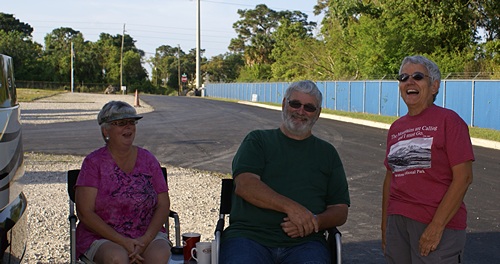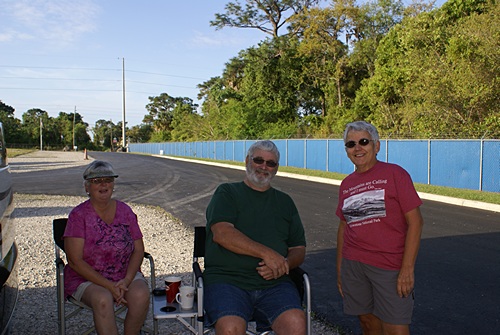I was up early today anticipating getting on the road again. We had a little juice and took our vitamins, but did not have coffee or breakfast. I generally do not eat or drink much in the morning on travel days. The bus was mostly ready to go except for last minute details and around 8 AM we shifted into departure mode. I opened the passenger-side engine bay door, opened the air supply valve to the engine accessories, unlatched the rear engine cover and raised it, and connected the coach chassis batteries. Since the engine ran a bit warm on the drive from Williston to Hudson I wanted to visually verify that that radiator fan was spinning.
While I waited for the Pressure Pro TPMS to pick up the pressure readings from all of the tires I closed all of the ceiling vents and the side windows. The driver-side front/steer tire pressure was a little lower than I like, the drive and tag tire pressures were OK. The passenger-side front/steer tire pressure was a little higher than I normally run, put not excessive and within the maximum cold pressure limits of the tire and wheel. I wrote down the tire pressures for reference later.
While Linda secured the inside I shut off the AC power, disconnected the power cord, stowed it for travel, and closed up the utility bay. Just before 8:30 AM I fired up the main engine, let the oil pressure build, and put it in high idle. The radiator fan was spinning as it should and I closed the rear hatch and side door on the engine compartment. Bill and Nancy were up and Bill guided me out of our parking spot while Linda kept an eye on the rear end of the bus. I only had to back up once, and only a little bit, to complete the turn. With the tag axle raised the turning radius of the coach is shortened enough to make a difference in slow, tight turns.
We need to find a large vacant parking lot, set up some cones, and practice maneuvering the bus in and out of tight spaces. I have driven the coach enough that I generally have a good feel for how it handles but our visit to Suncoast Designers revealed that our individual and team skill sets were incomplete. We do not have a good understanding of how to back it around into a narrow space starting from a perpendicular position. In particular we do not have a good feel yet for where the front tires are as the nose swings.
The centerline through the front tires is behind the driver, five feet from the front bumper. Bill had me pull much farther forward out of our site before turning the wheels hard left than seemed visually reasonable from the driver’s seat. As the front end came around I completely lost sight of the curb that ran along the far side of the road as it disappeared under the front of the coach. But Bill could see my tires and knew I was positioned correctly. He said I could probably have pulled out of the site without backing up, but the passenger-side front tire would have barely missed the curb. He had me turn the tires hard right and back up slightly, creating the additional space needed to complete the tight left turn out of the site and onto the road.
Nancy gave us a couple of business cards with their contact information and we said our farewells. I pulled out of Suncoast Designers at 8:45 AM with Linda following in the car. We got to the Tires Plus store just before 9 AM and got parked parallel to the end of the building. We checked all of the tire pressures again using the TPMS and recorded them. The pressure in all of the tires rose about 5 PSI in the eight mile drive. The technician was ready to go and was very patient as I removed each pressure sensor, checked the tire pressure with my gauge (that I have previously checked against a known good pressure standard), compared it to the two TPMS readings, determined how much additional pressure to have him add, checked it again, and put the pressure sensor back on. We thanked him for the service (no charge) and gave him a tip.
The sensors will have to be removed once we get to our destination and the tires have a chance to cool off. The baseline pressure is determined by the pressure in the tire when the sensor is installed and the warnings are triggered by deviations from the baseline. The overnight low from Tuesday into Wednesday is forecast to be 38 degrees F, so that will be the time to check and reset. The Pressure Pro was one of the early TPMS systems and this how it was designed. Newer systems permit the baseline pressure to be programmed into the receiver by tire position. Our sensors do not have user replaceable batteries and when they finally need to be replaced we will put that money towards a newer system.
Linda guided me as I backed the bus around behind the service bays. We hooked the car up for towing and did our light check. Our left turn signal on the car was not working, but everything else was OK. One of the sockets in the wiring connector on the car was slightly corroded so I cleaned it using the awl in my Leatherman multi-tool. That fixed the problem when we left Williston, but not this time. I examined the connector on the bus, and found that part of one of the pins was missing. This was almost certainly the left turn signal and there was nothing to be done about it at that moment. This is a standard 6-pin round RV/trailer connector. It was a cheap piece of junk the day it was made and did not improve with age. I will be replacing both connectors and the cable with products from EZ Connector. Weather sealed, gasketed, and magnetically retained with integrated self-closing covers; primo.
We pulled out onto US-19 northbound. The road construction workers had the day off and traffic was light so we had an easy run up to Crystal River, picking up the US-98 designation near Homosassa. Even with light traffic it took a while to get through Crystal River where the speed limit is often 30 – 35 MPH and there are frequent stop lights. Once we cleared Crystal River we were able to travel 60 MPH, plus or minus, for most of the rest of the trip except through Chiefland.
The Check Engine Light came on soon after we left Suncoast Designers and stayed on for quite a while. It eventually went off and only occasionally came back on, especially under acceleration or climbing hills. The engine coolant temperature gauge initially read below 195 degrees F, but morning temperatures were moderate. The sun was behind us and the coach stayed comfortable without the OTR air-conditioner. I don’t know how precise the engine temperature gauge is, but it does seem to be accurate. (Precision is the extent to which it shows the true/correct temperature; accuracy is the degree to which it is consistent or repeatable in terms of its readings.) The engine oil temperature came up to 186 degrees F on the gauge fairly quickly like it normally does. The transmission temperature gauge eventually came up to the same temperature but took a lot longer, as it normally does, even with the use of the transmission retarder going through Crystal River and Chiefland.
The GPS wanted us to take I-75 and was very persistent in trying to get us to leave our chosen route. It became humorous after awhile and we should have counted the number of times it said “recalculating.” We obviously had the preferences set to “maximize freeways” or something like that. It finally figured out what we were doing when we got to the US-19 US-98 split at Perry, Florida. US-98 turns west to WSW and follows the Gulf coast where it becomes a designated scenic drive. While probably beautiful, it would have been a longer route with lots of shore communities making it a long, slow drive. US-19 turned NNW and ran up to I-10 east of Tallahassee, Florida, the state Capitol.
The terrain had been essentially flat up to Perry, but part way to I-10 we encountered a hill; up one side and down the other. It just appeared out of nowhere as if someone had built it there just to get our attention. But then there was another hill, and another one and … we were north of “the bend” and officially entering the panhandle which, unbeknownst to us, was not flat like the parts of Florida where we had spent time this winter.
By the time we got to Perry the outside air temperature was in the low 80’s and the engine coolant temperature was indicating 195 or a hair under. The engine and transmission temperature were staying in the 186 to 190 range. The pyrometers came up to 700 – 900 degrees F on hills depending the grade and length. The cruise control ran perfectly all day, as it always has, but the speedometer sat on zero and never budged (accurate, but not precise).
Once on I-10 west we made good time traveling due west across the panhandle. The road was straight but had lots of ups and downs. The highest point in Florida is in the northwestern panhandle near the Alabama border. Just west of Tallahassee we stopped at a Flying J truck stop and travel center to top off our fuel tank. We continued west on I-10 and crossed into the Central Time Zone before exiting at US-331 and heading south towards the Gulf of Mexico and the towns of Freeport and South Walton. Fifteen miles from the Interstate we made our last few turns and arrived at Live Oak Landing RV park. We had traveled 350 miles in 7.5 hours including the fuel stop, but still a little below our usual 50 MPH average. We were tired when we arrived and Linda fixed a salad and pan grilled our last two tofu hot dogs.

